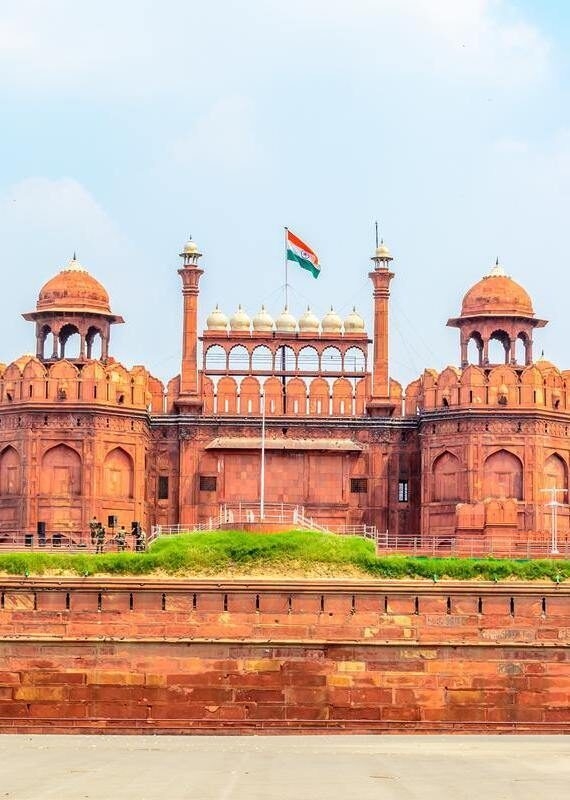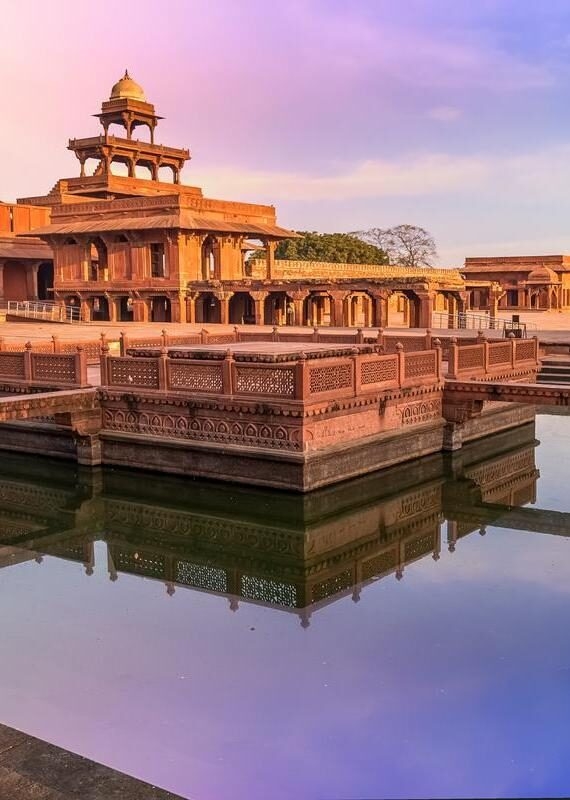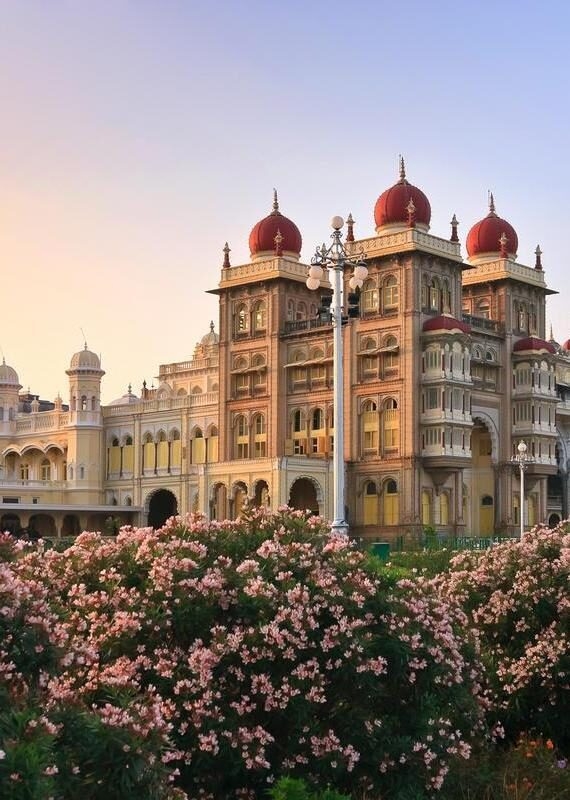India is an immense, multifaceted and fascinating country with heaps of historical landmarks scattered across it. It’s home to no fewer than 42 UNESCO World Heritage Sites, ranging from forts and palaces to temples and tombs. Each of the seemingly infinite landmarks in India is replete with cultural heritage, and many are imbued with spiritual significance as well.
Considering the sheer number of famous landmarks in India, choosing which ones to visit is no simple task. That’s why our team of travel designers who specialise in the Indian Subcontinent have compiled their selections for the best of the best: nine structures, cities and monuments that are just as impressive and awe-inspiring as they are historically important.

1. Taj Mahal – Agra
Easily India’s most famous landmark, the Taj Mahal is an undeniable emblem of the country’s culture. Located in the city of Agra in Uttar Pradesh, it exemplifies the Mughal architectural style and is known the world over as a symbol of love. It’s also one of the most visited sites in India.
Beyond the mausoleum’s famous facade and reflecting pool, the Taj Mahal also boasts extensive gardens, a mosque, a guest house and a gorgeous interior that’s well worth seeing. Go at sunrise or sunset for the best light and smaller crowds. Our travel designers suggest visiting between October and March to catch the best weather for sightseeing.

2. Golden Temple – Amritsar
Set at the northwestern edge of India, right on the border with Pakistan, is the holy city of Amritsar. At its centre you’ll find the shimmering Golden Temple, or Harmandir Sahib: one of the most important gurdwaras (worship sites) in the Sikh religion.
The Golden Temple is surrounded by a man-made lake whose waters are said to hold healing power. Visit in the evening to see the building illuminated after dark and witness the Palki Sahib ceremony, which involves putting the holy scripture, the Guru Granth Sahib, to rest for the night.

3. India Gate – Mumbai
If you want to understand India’s complex cultural tapestry, the India Gate is a great place to start. Also known as the Gateway of India, this monumental arch encapsulates the influence of British colonial rule during the 20th century, as well as the country’s modern identity.
Since its construction in the 1920s, the gateway has come to symbolise the city of Mumbai. It was originally built to welcome British monarchs, but also marks the spot where the final British troops withdrew in 1948. Its design blends the classical form of a Roman triumphal arch with Hindu and Muslim elements.

4. Red Fort – Delhi
One of India’s dozens of UNESCO World Heritage Sites, the Red Fort in Delhi is a must-see when visiting the country’s capital. This red sandstone structure once housed Mughal emperors and was designed by the same architect responsible for the Taj Mahal.
This imposing fortress was constructed in the 17th century at the behest of Shah Jahan (once again, the same emperor who commissioned the Taj Mahal). You can also visit the nearby Salimgarh Fort, which is even older; it was built in the 16th century by ruler Salim Shah Suri.

5. Fatehpur Sikri – Agra
India clearly has its fair share of jaw-dropping buildings, but how about an entire deserted city? Enter Fatehpur Sikri: a 16th-century Mughal city located near Agra. Originally intended to be the capital of the Mughal Empire, it only held this distinction for about 14 years. It was completely abandoned a few decades later, due at least partly to water scarcity.
Visiting Fatehpur Sikri today provides an intriguing glimpse into Mughal city planning and public spaces. Its red sandstone buildings include the grand Jama Masjid (mosque), the tomb of Salim Chisti and the Panch Mahal (a five-level palace).

6. Agra Fort – Agra
Most travellers head to Agra to see the Taj Mahal, but it’s worth sticking around to visit the nearby Agra Fort as well. Like some of the other landmarks on this list, it’s known for its red sandstone exterior. Inside you’ll find intricate carvings and white marble details.
There are plenty of interesting structures to explore within the Agra Fort, including the Sheesh Mahal (a palace decorated with tiny pieces of mirror), Machchi Bhawan (a garden that once held tanks of sacred fish) and the white marble Moti Masjid (‘Pearl Mosque’).

7. Qutb Minar – Delhi
One of the most interesting things about India is its diversity of languages, cultures and religions, all of which are reflected to some extent in its landmarks. For example, the Qutb Minar in Delhi is the world’s tallest brick minaret, dating back to the start of Muslim rule in the country.
The Qutb complex includes the soaring minaret, which is 72.5 metres (238 feet) tall, and surrounding structures like the Alai Darwaza gateway, the Alai Minar tower and the mysterious Iron Pillar. You can also visit the beautiful Humayun’s Tomb nearby.

8. Hawa Mahal – Jaipur
Jaipur is undoubtedly one of the best places to visit in India, packed with architectural wonders and the distinctively coloured buildings that explain its nickname: the Pink City. The Hawa Mahal is one of its most unique structures, featuring five storeys and an elaborate facade with 953 small windows.
There’s a curious story behind this design. When the palace was built in 1799, royal women weren’t allowed to be seen in public. The Hawa Mahal’s hundreds of windows allowed them to observe what was going on outside from the privacy of the palace.

9. Mysore Palace – Mysore
Mysore (officially Mysuru) is sometimes called the ‘City of Palaces’ – and the Mysore Palace is right at its heart. Also known as the Amba Vilas Palace, it’s an eclectic combination of several different styles, including Mughal, Rajput, Gothic and Islamic architecture.
Designed by the British architect Henry Irwin, the Indo-Saracenic building dates back to around the turn of the 20th century. Keep an eye out for the gorgeous stained-glass windows, tiled floors and ivory inlaid doors.
Embark on an Indian adventure
Embark on an unforgettable adventure tailored just for you with Jacada Travel. Whether you're drawn to the intricate facades of opulent palaces or deserted cities lost in time, India is a land of rich culture and unforgettable experiences. Let our expert travel designers craft a bespoke itinerary that captures your imagination and exceeds your expectations.









